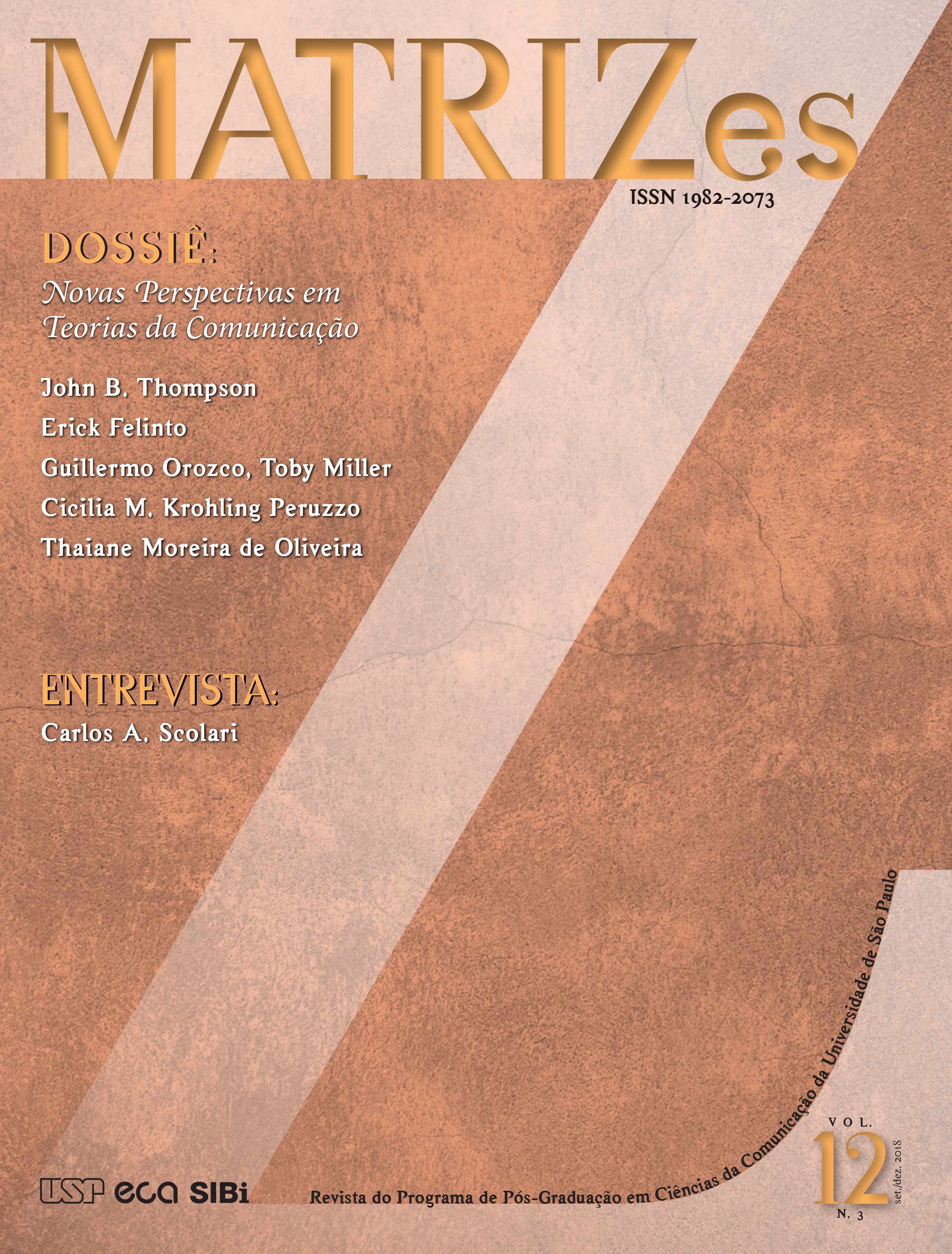Mediated interaction in the digital age
DOI:
https://doi.org/10.11606/issn.1982-8160.v12i3p17-44Palabras clave:
Communications, Interaction, Media, Visibility, WhistleblowersResumen
In The media and modernity, Thompson develops an interactional theory of communication media that distinguishes between three basic types of interaction: 1) face-to-face interaction, 2) mediated interaction, and 3) mediated quasi-interaction. In the light of the digital revolution and the growth of the internet, this paper introduces a fourth type: mediated online interaction. Drawing on Goffman’s distinction between front regions and back regions, Thompson shows how mediated quasi-interaction and mediated online interaction create new opportunities for the leakage of information and symbolic content from back regions into front regions, with consequences that can be embarrassing, damaging and, on occasion, hugely disruptive.
Descargas
Referencias
BAYM, N. K. Personal connections in the digital age. 2. ed. Cambridge: Polity, 2015.
BOORSTIN, D. J. The image: a guide to pseudo-events in America. Nova York: Random House, 1961.
BOYD, d. m.; ELLISON, N. B. Social network sites: definition, history, and scho-larship. Journal of Computer-Mediated Communication, Oxford, v. 13, n. 1, p. 210-230, 2008. DOI: https://doi.org/10.1111/j.1083-6101.2007.00393.x
BROWN, Gordon. The Gordon Brown and Gillian Duffy transcript. The Guardian, 2010. Disponível em: https://www.theguardian.com/politics/2010/apr/28/gordon-brown-gillian-duffy-transcript. Acesso em: 11 dez. 2018
CASTELLS, M. Communication power. Oxford: Oxford University Press, 2009.
CHADWICK, A. The hybrid media system: politics and power. Oxford: Oxford University Press, 2013.
GIBSON, J. J. The theory of affordances. In: ______. The ecological approach to visual perception. Boston: Houghton Mifflin, 1979. p. 127-137.
GILLESPIE, T. The relevance of algorithms. In: GILLESPIE, T.; BOCZKOWSKI, P. J.; FOOT, K. A. (Eds.). Media technologies: essays on communication, materiality, and society. Cambridge: MIT Press, 2014. p. 167-193.
BOCZKOWSKI, P. J.; FOOT, K. A. (Eds.). Custodians of the Internet. New Haven: Yale University Press, 2018.
GOFFMAN, E. The presentation of self in everyday life. Harmondsworth: Penguin, 1969.
MADIANOU, M. Ambient co-presence: transnational family practices in polymedia environments. Global Networks, Hoboken, v. 16, n. 2, p. 183-201, 2016. DOI: https://doi.org/10.1111/glob.12105
MADIANOU, M.; MILLER, D. Polymedia: towards a new theory of digital media in interpersonal communication. International Journal of Cultural Studies, Thousand Oaks, v. 16, n. 2, p. 168-187, 2012. DOI: https://doi.org/10.1177/1367877912452486
THOMPSON, J. B. The media and modernity: a social theory of the media. Cambridge: Polity, 1995.
THOMPSON, J. B. Political scandal: power and visibility in the media age. Cambridge: Polity, 2000.
TURNER, F. Trump on Twitter: how a medium designed for democracy became an authoritarian’s mouthpiece. In: BOCZKOWSKI, P. J.; PAPACHARISSI, Z. (Eds.). Trump and the media. Cambridge: MIT Press, 2018. p. 143-149.
Descargas
Publicado
Número
Sección
Licencia
Los autores que publican en esta revista aceptan los siguientes términos:
- Los autores mantienen los derechos de autor y otorgan a la revista el derecho a la primera publicación, con el trabajo licenciado simultáneamente bajo la Creative Commons Attribution License (CC BY-NC-SA 4.0) que permite compartir el trabajo con reconocimiento de autoría y publicación inicial en esta revista para fines no comerciales.
- Los autores están autorizados a asumir contratos adicionales por separado, para la distribución no exclusiva de la versión del trabajo publicado en esta revista (por ejemplo: publicación en repositorio institucional o como capítulo de libro), con reconocimiento de autoría y publicación inicial en esta revista.






















